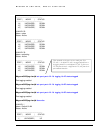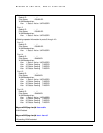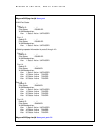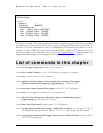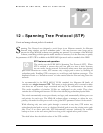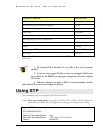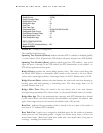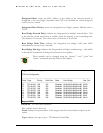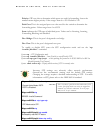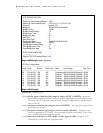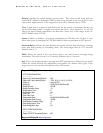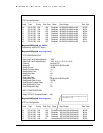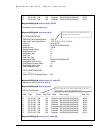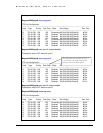
MAGNUM 6K SWITCHES, MNS-6K USER GUIDE
149
Bridge ID : 80:00:00:20:06:25:ed:80
Bridge Priority : 32768
Bridge Forward Delay : 15
Bridge Hello Time : 2
Bridge Max Age : 20
Root Port : 0
Root Path Cost : 0
Designated Root : 80:00:00:20:06:25:ed:80
Designated Root Priority : 32768
Root Bridge Forward Delay : 15
Root Bridge Hello Time : 2
Root Bridge Max Age : 20
RSTP CONFIGURATION
-----------------
Rapid STP/STP Enabled(Global) : NO
Magnum6K25#
F ing STP configuration
The variables listed above are:
bal): indicates whether STP is enabled or disabled globally
panning Tree Enabled (Ports): indicates which ports have STP enabled – note in the
ridge Priority: specifies the switch (bridge) priority value. This value is used along with
ridge Forward Delay: indicates the time duration the switch will wait from listening to
ridge Hello Time: When the switch is the root device, this is the time between
ridge Max Age: This is the maximum time a message with STP information is allowed
oot Port: indicates the port number, which is elected as the root port of the switch. A
oot Path Cost: A path cost is assigned to individual ports for the switch to determine
converge – resulting in a slower system
IGURE 83 – View
Spanning Tree Enabled (Glo
i.e. if the values is YES, all ports have STP enabled, otherwise, all ports have STP disabled
S
figure the ports 9 through 16 are STP enabled, but STP functionality is not enabled – so
STP will not perform on these ports
B
the switch MAC address to determine which switch in the network is the root device.
Lower values mean higher priority. Value ranges from 0 to 65535. Default value is 32768
B
learning states and from learning to forwarding states. The value ranges from 4 to 30
seconds. Default value is 15
B
messages being transmitted. The value is from 1 to 10 seconds. Default value is 2 seconds
B
by the switch before the switch discards the information and updates the address table
again. Value ranges from 6 to 40 seconds with default value of 20 seconds
R
root port of “0” indicates STP is disabled
R
which ports are the forwarding points. A higher cost means more loops, a lower cost
means fewer loops. More loops equal more traffic and a tree which takes a long time to



